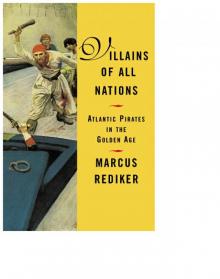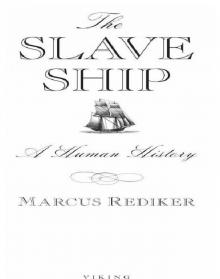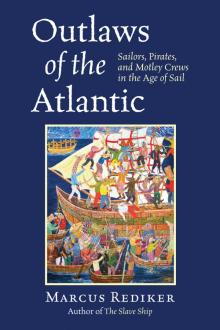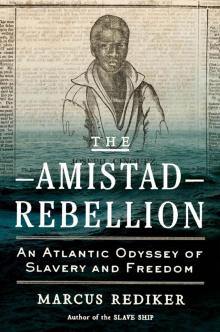- Home
- Marcus Rediker
Villains of All Nations Page 9
Villains of All Nations Read online
Page 9
Some crews attempted to circumvent disciplinary problems by taking “no Body against their Wills.”42 By the same logic, they would keep no unwilling person. The 1718 confession of pirate Edward Davis indicates that oaths of honor were used to cement the loyalty of new members: “at first the old Pirates were a little shy of the new ones, ... yet in a short time the New Men being sworn to be faithful, and not to cheat the Company to the Value of a Piece of Eight, they all consulted and acted together with great unanimity, and no distinction was made between Old and New.”43
This passage raises a question: how did pirates create and re-create their culture? The answer depends on the way in which a gang of pirates formed. Mutineers had to organize a founding moment, and already-constituted pirate ships devised rituals of integration for volunteers. The mutiny on the Buck was an important example of the former, as it represented the origin of the lineage that would lead to Bartholomew Roberts and his capture of four hundred vessels between 1719 and 1722. Mate Howell Davis knew that many former pirates and other hands were “ripe for Rebellion” aboard the ship and easily organized the mutiny, which proved successful. The outlaws immediately called a “Counsel of War,” a meeting of all members of the ship, over “a large Bowl of Punch,” to choose a commander. They voted for Davis “by a great Majority,” and eventually “all acquiesced in the Choice.” The next step was constitutional, the drawing up of articles, the rules by which they would operate, “which were signed and sworn by himself [Davis] and the rest.” The new pirate commander then “made a short speech, the sum of which was a Declaration of War against the whole World.” Then they “consulted” about where to go and what to do, and soon they were off on their adventure.44
Figure 3. George Lowther; Captain Charles Johnson, A General History of the Lives and Adventures of the Most Famous Highwaymen, Murderers, Street Robbers, &c. (London, 1734).
Other mutinous crews did the same. Edward Worley and his crew made “a black Ensign, with a white Death’s Head in the middle of it,” signed articles, and “bound themselves under a solemn Oath, to take no Quarters, but to stand by one another to the last Man.” The rebels on the Royal African Company ship the Gambia Castle met with leaders George Lowther and John Massey. They “agreed to go a pirating and took Oaths & entered into Articles in writing for that purpose & prepared black Colours.” They also “knocked down the Cabins, made the Ship flush fore and aft,” and renamed her the Delivery. Things worked similarly when a ship divided and a new captain was elected and installed. Such was the case with Francis Spriggs, whose crew created its own Jolly Roger and fired their guns to salute the new captain.45
How did pirates integrate newcomers into the life and work of the ship? This was especially important because a large majority of pirates had not been mutineers but had joined as volunteers from captured vessels. The initiation process usually included signing the articles and taking an oath to “swear to true to the Crew” as, for example, carpenter John Haswell did when he joined the crew of Howell Davis. Newcomers then had to demonstrate their commitment to the enterprise, and this usually took time. Pirate captain Thomas Cocklyn apparently felt that the “new-entered men” would not truly be part of the pirate community until they had seen action in battle. They must, he said, “learn to smell gunpowder.” Cocklyn was said to use the boatswain’s rattan cane on the new men, and Israel Hynde, boatswain on Roberts’s ship The Ranger, “was always swearing and cursing at the new Pyrates.” James Phillips often tried “to terrifie new Comers if they offer’d to Speak saying that they ought to serve their time first.”46
The older pirates placed restrictions on the new ones until the latter had proved that they were “trusty” men or “brisk hands.” On several ships, “no new-Comer amongst the Company were suffered to goe a plundering of any Prize.” Thomas Davis testified that men were excluded from democratic discussion and decision making on Bellamy’s ship until they had signed the articles: “When the company was called to Consuls [councils], and each Man to give his Vote, they would not allow the forced Men to have a Vote.” On the Cassandra, “the Surgeons had no vote,” presumably because their class background (or forced status) made them untrustworthy. The process of integration was not without tension. “The old Pyrates were always jealous of the new Comers, and consequently observant of their Behaviour; this was done with the utmost Caution.” They imposed a public inspection of all formal communication: “no Man was suffered to write a word, but what was Nailed up to the Mast.”47
The transmission of pirate culture through space and time was linked closely to their success in attracting new recruits and to their democratic—one might say anarchic—form of self-organization. As more and more volunteers joined the pirates, and as the ship became more crowded, the moment inevitably arrived when the crew would split. When a suitable vessel was taken (one with the appropriate size, speed, and ordnance), those who wanted to set up independently would draw up their own articles, elect a captain, and constitute themselves as a new crew. Another common reason for splitting was a developing conflict within an existing crew—over leadership, where to cruise, and so on—whereupon a dissident portion would elect its own captain and sail away from their former mates. The social organization constructed by pirates was flexible, but it could not accommodate severe, sustained conflict. Those who had experienced the claustrophobic and authoritarian world of the merchant ship cherished the freedom to separate. The pirates’ democratic exercise of authority had both negative and positive effects. Although it produced a chronic instability, it also guaranteed continuity; the very process by which new crews were established helped to ensure a cultural continuity among the pirates.48
The mechanism for the continuity can be seen by charting the connections among pirate crews. The accompanying diagram, arranged according to vessel captaincy, demonstrates that by splintering, by sailing in consorts, or by other associations, roughly thirty-six hundred pirates—about 90 percent of all those active between 1716 and 1726—fitted into two main lines of genealogical descent. Captain Benjamin Hornigold and the pirate rendezvous in the Bahamas stood at the origin of an intricate lineage that ended with the hanging of John Phillips’s crew in June 1724. The second line, spawned in the chance meeting of the lately mutinous crews of George Lowther and Edward Low in 1722, culminated in the executions of William Fly and his men in July 1726. It was primarily within and through this network that the social organization of the pirate ship took on its significance, transmitting and preserving customs and meanings, and helping to structure and perpetuate the pirates’ social world.49
Figure 4. Connections among pirate crews, 1714–1727.
What was spreading, hydralike, in the division of pirate crews was a radical democratic social order and culture, with distinctive social attitudes and relations, both within the group and without. One aspect was especially troubling to authorities, as described by Governor Alexander Spotswood as he sought “some safe opportunity” to sail from Virginia to London in 1724. He discovered that he could do so only in a well-armed man-of-war:
Your Lordships will easily conceive my Meaning when [you] reflect on the Vigorous part I’ve acted to suppress Pirates: and if those barbarous Wretches can be moved to cut off the Nose & Ears of a Master for but correcting his own Sailors, what inhuman treatment must I expect, should I fall within their power, [I] who have been markt as the principle object of their vengeance, for cutting off their arch Pirate Thatch [Teach, or Blackbeard], with all his grand Designs, & making so many of their Fraternity to swing in the open air of Virginia.50
Spotswood knew these pirates well. He had authorized the expedition that returned to Virginia boasting Blackbeard’s head as a trophy. He had done his share to ensure that many pirates would swing on Virginia gallows. He knew that pirates had a fondness for revenge, that they often punished ship captains for “correcting” their crews, and that a kind of “fraternity” prevailed among them. He had good reason to fear them, as we will see in the f
ollowing chapter.
5. “To Do Justice to Sailors”
IN 1720, AS EDWARD ENGLAND and Oliver LaBouche and their crews prowled the western Indian Ocean around the island of Johanna, off Madagascar, they spied a vessel that proved to be the Cassandra, commanded by James Macrae. Little did the pirates know it, but Macrae, who worked for the East India Company, was coming after them. He and the captain of another ship had concluded that “it might be of great Service to the East-India Company to destroy such a Nest of Rogues” who had disrupted the lucrative commerce of the region. When the pirates approached and ran up the dreaded Jolly Roger, Macrae did not surrender as most merchant captains would have done in such a situation. Rather, he and his crew announced their intentions with their cannon, beginning a hot three-hour engagement that would make the decks of both ships slick with blood and littered with dead bodies. The pirates at some point raised their red or “bloody” flag, as they called it, indicating that they would neither take nor give quarter. It would be a fight to the death.1
Eventually the pirates prevailed, not least because two consort ships whose captains had vowed to fight with Macrae against the pirates lost heart and sailed away. Macrae himself, bleeding profusely from a wound to his head by a musket ball, nonetheless managed to gather the survivors into a long boat and row ashore to King’s Town, Johanna. But now there was no escaping the pirates, who anchored offshore and put out word that they would pay a ten-thousand-crown bounty to anyone who would deliver Macrae to them. They wanted his head. It was their customary practice to torture and kill those who dared to resist them, to teach them a lesson by terror, especially when the blood of their own comrades had been spilled in battle. When Macrae was finally taken aboard England’s ship, he must have assumed that he was going to his death.
As the drama concerning his fate unfolded on the quarterdeck, there suddenly appeared “A fellow with a Terrible Pair of Whiskers, and a wooden Leg,” a pirate who had come up from belowdecks. He was “stuck round with Pistols, like the man in the Almanack with Darts.” He lurched along, swinging his peg leg, “swearing and vapouring,” and asked, “in a damning Manner, which was Captain Mackra.” The very sight of the man nearly scared the captain out of his wits; he was sure that “this Fellow would be his Executioner.”
But when the fierce man came near Macrae, “he took him by the hand, swearing, damn him he was glad to see him.” As it happened, this particular pirate, like several others, “had formerly sail’d with him” and took the opportunity to announce to the assembled crew that Macrae was “an honest Fellow.” For good measure, he added (no doubt with a few salty oaths), “shew me the Man ... that offers to hurt Captain Mackra, for I’ll stand by him.” He had invoked the strongest expression of seafaring solidarity—to stand by someone, a favorite among pirates—and he meant it in a confrontational way. Anyone who wished to get at Macrae would have to go through him. The magnanimous gesture earned the captain a reprieve until the matter could be taken up in a common council. Macrae himself had no illusions, as he later noted: “several of the Chief of them knew me, and some of them had sailed with me, which I found of great Advantage; because, notwithstanding their promise [of his personal safety], some of them would have cut me, and all that would not enter with them, to Pieces.”
The pirates then held a “Consultation amongst themselves,” at which the bewhiskered peg leg and many others had their say. They concluded: “considering the gallant Behaviour of Capt. Mackray”—they admired his pluck—“and what a good Character he bore Amongst his Men”—he was “an honest Fellow”—they would not only let him live, but decided “to return him another ship in room of his own,” which had been severely damaged in battle. His life saved and the gift ship accepted, Macrae sailed away, his pluck intact, to obtain reinforcements, and he soon returned to engage the pirates in battle once again and try to kill or capture them. The pirates must have been stunned, but soon disbelief turned to white-hot rage. One of them remarked that Macrae’s actions represented an abuse of “civillity,” and he vowed never to let a merchant captain off the hook ever again.2
The story of Captain Macrae among the pirates raises an issue to be probed in this chapter: why did pirates care whether he or any other ship captain happened to be “an honest Fellow”? Why did it matter to them “what a good Character he bore Amongst his Men”? Having explored the social origins and self-organization of pirates aboard their ship, we now move to their social relations. This is an important topic because pirates constructed their own social order in defiant contradistinction to the ways of the world they had left behind. They had special contempt for the merchant captain, the royal official, and the system of authority those figures represented and enforced. In 1718, when eight pirates were tried in Boston, merchant captain Thomas Checkley told of the capture of his ship by pirates, who “pretended,” he said, “to be Robbin Hoods Men.” Herein lies a clue about their self-perception and their relations to others.3
Robin Hood was, of course, the legendary figure who in late medieval England “robbed from the rich and gave to the poor.” He was the preeminent social bandit, the man who was, to the upper classes of his day, a criminal, but at the same time a hero to the lower orders. Historian Eric Hobsbawm has described social banditry as a “universal and virtually unchanging phenomenon,” an “endemic peasant protest against oppression and poverty: a cry for vengeance on the rich and the oppressors.” Its goal is “a traditional world in which men are justly dealt with, not a new and perfect world”; Hobsbawm calls its advocates “revolutionary traditionalists.” The pirates who emerged after the War of Spanish Succession were not peasants, of course, but they certainly did, as we have seen, protest against oppression and poverty as they built a new world aboard their ships. Of special importance was their “cry for vengeance.”4
When Governor Alexander Spotswood spoke of pirates as “barbarous Wretches [who] can be moved to cut off the Nose & Ears of a Master for but correcting his own Sailors,” and of himself as “the principle object of their vengeance” for having killed Blackbeard and hanged others, he articulated the fears of royal officials and merchant captains everywhere about the pirates and their fondness for revenge.5 The very names of pirate ships made the same threat. Blackbeard’s vessel was named Queen Anne’s Revenge; other notorious craft were Stede Bonnet’s Revenge, John Cole’s New York Revenge’s Revenge, and William Fly’s Fames’ Revenge.6 The foremost target of vengeance was the merchant captain. Frequently, “in a far distant latitude,” as one seaman put it, “unlimited power, bad views, ill nature and ill principles all concur[red]” in a ship’s commander. Here was a man “past all restraint,” who often made life miserable for his crew.7 In 1722 merchant captains Isham Randolph, Constantine Cane, and William Halladay petitioned Spotswood “in behalf of themselves and other Masters of Ships” for “some certain method ... for punishing mutinous & disobedient Seamen.” They explained that captains faced great danger “in case of meeting with Pyrates, where we are sure to suffer all the tortures w[hi]ch such an abandoned crew can invent, upon the least intimation of our Striking any of our men.” Pirates acted the part of a floating mob, a “flying gang,” as they called themselves, with its own distinctive sense of popular justice.8
Upon seizing a merchantman, pirates often administered the “Distribution of Justice,” “enquiring into the Manner of the Commander’s Behaviour to their Men, and those, against whom Complaint was made” were “whipp’d and pickled.”9 The practice of investigating the master’s usage of his men was so widespread that it was called a “Custom” among the pirates. Bartholomew Roberts’s crew considered such inquiry so important that they formally designated one of their men, George Willson, as the “Dispencer of Justice.” In 1724 merchant captain Richard Hawkins described another form of retribution, a torture known as the “Sweat”: “Between decks they stick Candles round the Mizen-Mast, and about twenty-five men surround it with Points of Swords, Penknives, Compasses, Forks &c in each of th
eir hands: Culprit enters the Circle; the Violin plays a merry Jig; and he must run for about ten Minutes, while each man runs his Instrument into his Posteriors.”10 Many captured captains were “barbarously used,” and some were summarily executed. Pirate Philip Lyne carried this vengeance to its bloodiest extremity, confessing when apprehended in 1726 that “during the time of his Piracy” he “had killed 37 Masters of Vessels.”11 The search for vengeance was in many ways a fierce, embittered response to the violent, personal, and arbitrary authority wielded by the merchant captain.
Still, the punishment of captains was not indiscriminate, as the case of Captain Macrae suggests. A few captains were singled out for reward by pirates. The best description of pirates’ notions of justice comes from merchant captain William Snelgrave’s account of his capture in 1719. On April 1 Snelgrave’s ship was seized by Thomas Cocklyn’s crew of rovers at the mouth of the Sierra Leone River. Cocklyn was soon joined by men captained by Oliver LaBouche and Howell Davis, and Snelgrave spent the next thirty days among 240 pirates. His account is one of the most insightful ever written about social attitudes and practices among the pirates. Let us examine it carefully.12

 Villains of All Nations
Villains of All Nations The Slave Ship
The Slave Ship Outlaws of the Atlantic
Outlaws of the Atlantic The Amistad Rebellion
The Amistad Rebellion